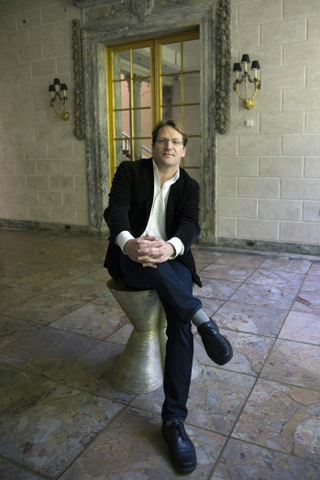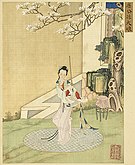
The Minzu University of China is a national public university in Beijing, China. The university is affiliated with the National Ethnic Affairs Commission of China.

Stories and practices that are considered part of Korean folklore go back several thousand years. These tales derive from a variety of origins, including Shamanism, Confucianism, Buddhism, and more recently Christianity.
The Cerebral Palsy International Sports and Recreation Association (CPISRA) is an international sports and recreation association for cerebral palsy and related neurological conditions. CPISRA organise recreational opportunities, develop adaptive sports and organise sport events for people with Cerebral Palsy and related neurological conditions. CPISRA was formed in 1969. It is made up of worldwide members and a community of volunteers including an advisory board, specialist committees and networks.

The Guan Li is the Confucian coming of age ceremony. According to the Li Ji, it is only after the coming of age ceremonies that young people could call themselves adults and could share social responsibilities. The name Guan Li refers to the ritual ceremony for men which involves the use of a guan, while the Ji Li refers to the one for women and involves the use of a ji. Both the Guan Li and Ji Li have important symbolic meaning for the Han Chinese. Both of these ceremonies are key Confucian rites, and are part of the "four rites", along with marriage, mourning rites, and sacrificial rituals.

Dunhuang Dance is a form of Chinese dance which combines traditional culture and modern art. Dunhuang dance draws inspiration from the body movements in the Dunhuang grotto frescoes, and the musical instruments and music scores found in Dunhuang, Gansu province, West China. The dance shows the combination of ethnic dance styles from Central and Western China. The dances itself is also influenced by Buddhist images and Buddhism.

Raffles Hotels & Resorts is a Singaporean chain of luxury hotels which traces its roots to 1887 with the opening of the original Raffles Hotel in Singapore. The company started to develop internationally in the late 1990s. Since 2015, Raffles is part of Accor.

Santee Smith Tekaronhiáhkhwa is a Canadian Kahnyen’kehàka (Mohawk) multidisciplinary artist, dancer, designer, producer, and choreographer of the Turtle Clan from Six Nations of the Grand River. She has used her voice and research to create dance works representing Indigenous identities. She is an advocate for Indigenous performances and is one of Canada's most dominating dance artists. Santee Smith has amassed many awards throughout her career and in 2019, she was appointed Chancellor of McMaster University in Hamilton, Ontario, Canada.

The Volkswagen Taos is a compact crossover SUV manufactured and marketed by Volkswagen. It was first released in October 2018 as the Volkswagen Tharu in China, while the Taos was released in October 2020 as a restyled version of the Tharu for the North America, South America, and Russia. The vehicle is positioned below the Tiguan, and in South America and China above the T-Cross.

Miss Earth 2021 was the 21st edition of the Miss Earth pageant, held virtually on November 21, 2021 due to the ongoing COVID-19 pandemic.
European Speedrunner Assembly, formerly European Speedster Assembly, is a semi-annual video game speedrunning charity marathon held in Sweden. Held since 2012, the events have raised hundreds of thousands of dollars for several charities.
"Shine" is a song recorded by South Korean boy group Pentagon. It was released on April 2, 2018, by Cube Entertainment and distributed by LOEN Entertainment as the lead single from the group's third extended play Positive. The Japanese version of the song was released by Cube Entertainment Japan, distributed by Universal Music Japan on August 29, 2018. The track was written by E'Dawn, Hui, Yuto, Wooseok with Flow Blow credited as the producer. This is the last Korean single to feature E'Dawn due to his hiatus and subsequent departure from the group.

Fabrice Jaumont is a French-born author and educator best known for his advocacy for dual-language bilingual education around the world. He is the author of several books translated in multiple languages.

Shubi, also called as zhi, is a generic term used for Chinese combs in China, which includes thick-teeth comb shu and thin-teeth comb bi. Shubi originated about 6000 years ago in China during the late Neolithic period. Some Chinese combs dating from the Shang dynasty were found in the Tomb of Fuhao. In ancient China, Chinese combs had a high special status, a high artistic value, was an important form of hair ornament in Chinese history. Chinese comb also had and continues to hold unique cultural meaning and emotional value. Chinese combs in China were not used only for grooming purposes, they were also used holding and decorating hair. Both Chinese men and women wore decorative combs in their hair in ancient China. Chinese women often wore combs and fine-tooth combs in their hair buns. Chinese comb-making was also an important form of traditional Chinese art and business industry.

Ji Li, also known as the hairpin ceremony, is the equivalent of the Guan Li; the Ji Li marks the transition from childhood to adulthood of a Chinese woman and involves the use of a ji. It is only after the Ji Li ceremony that a woman is considered an adult and is therefore eligible to be married. In ancient times, the Ji Li ceremony could be performed by people of any social class; however, rich people were more likely to hold the ceremony than poor people.
























